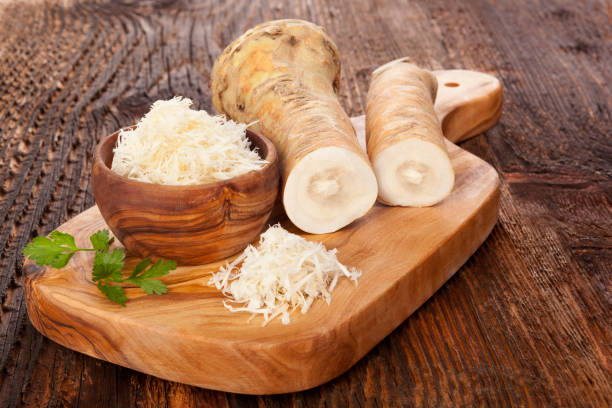Horseradish can be more than spicy
The History of Horseradish
Horseradish, which is also called horseradish in some German-speaking areas, originally comes from south-eastern Europe. There are various theories as to how it got its name and whether it actually has anything to do with the “sea” or the Slavic. The fact is that it was already known in antiquity, in the Middle Ages in Europe it was a much-appreciated plant with healing powers, and in the 13th-century people were well aware of the healing effects of horseradish. It could not be missing in any monastery garden, since at the beginning of its career it was seen more as a medicine than as a spice.
Styria in particular has been a traditional horseradish growing region since 1850. With around 380 hectares, Southeast Styria is the largest contiguous horseradish growing area in Europe and produced around 3,000 tons of Styrian horseradish in 2017.

Horseradish is healthy!
Today we know what makes horseradish healthy. Its high vitamin C content (177 mg/100 mg horseradish) even trumps that of lemon (only 53 mg/100 mg; source: LK Steiermark)! Especially in the cold season, 1 tablespoon of grated horseradish a day is said to protect against colds. If the viruses have already been able to strike, a horseradish pad on clogged sinuses, for example, helps.
In addition, the miracle root is said to help with coughs, rheumatism, gout, high blood fat levels, insect bites, and nerve pain and promote both digestion and kidney activity.
The ingredients in the horseradish are to blame when tears well up in our eyes. This is where the mustard glycosides in horseradish come into play. Together with vitamin C, vitamin B1, B2, and B6 and minerals such as potassium, calcium, iron, magnesium, and phosphorus, the so-called mustard oils ensure the antibacterial effect of horseradish. It is also called the “penicillin of the garden”.
Styrian horseradish PGI
Since 2009, Styrian horseradish has been allowed to bear the seal of quality of the European protection of origin and is called “Styrian horseradish g.g.A.”. possibly a logo??? But what makes the Styrian horseradish so special? – It must be due to the loving care of the Styrian horseradish farmers. A proverb says: “Styrian horseradish wants to see its master every day.” The careful nurturing and care of this plant involves 800 working hours per hectare of cultivation area. Only the Styrian horseradish is placed in the ground in spring, which means that the horseradish root is planted horizontally in the ground.
From the end of May, the horseradish roots that have grown from this are lifted by the farmers, i.e. taken out of the ground, and the side shoots of the roots are removed by hand before the horseradish is allowed to go back into the ground – horizontally, of course! The horseradish root becomes a strong stick and the horseradish head becomes particularly thick! “A curved, strong head is the hallmark of Styrian horseradish,” says Martin Kern, chairman of the Styrian horseradish farmers.
Styrian horseradish is “matured”, i.e. harvested, twice a year: the first half in November, the second half in March. Styrian soil is the best storage place for the wonderful root. Styrian horseradish is available all year round.

Extra tip: This is how you avoid burning eyes when tearing horseradish!
Connoisseurs agree that horseradish is worth every tear shed in its preparation. However, that doesn’t have to be the case! Just take a sip of water in your mouth when tearing the horseradish! This keeps us from crying. Sounds banal, but it actually works! Try it!
You’ve to whet your appetite for horseradish. Then try one of our Styrian horseradish recipes!
